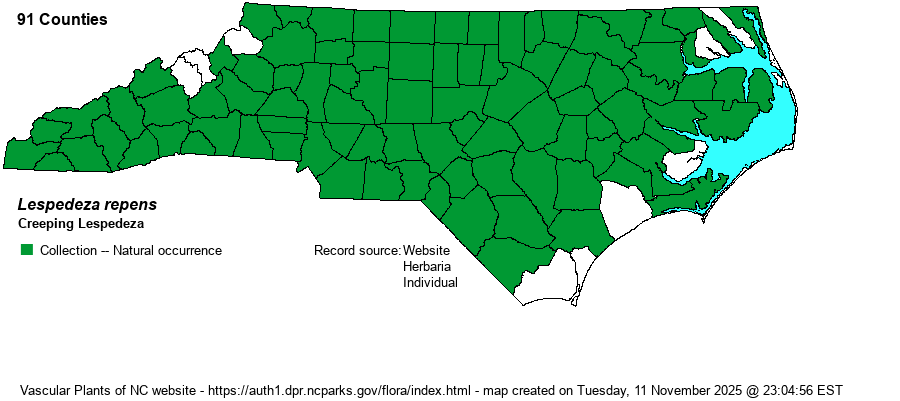| Author | (L.) W.P.C. Barton | |
| Distribution | Essentially statewide, though of spotty occurrence along the coast. Nonetheless, likely occurs in all 100 counties. Owing to the difficulty of separating this species from the very similar L. procumbens from photos, reports from iNaturalist, even of Research Grade, are not added to the map.
This species has a wide range across the Eastern states, ranging north to NY and IA, and south to central FL and central TX. | |
| Abundance | Common across the Mountains, Piedmont, and most of the Coastal Plain; infrequent to locally fairly common in coastal counties. | |
| Habitat | This species and L. procumbens are very similar in appearance, habits, and habitats, as well as range. Both occur in dry to (less often) mesic soil of woodland borders and edges, or in openings within woods. They tend to favor at least some shade, and are not numerous in wide open places like powerline clearings or overgrown fields. Habitat distinctions between these two do not seem to have been described, at least in NC. | |
| Phenology | Blooms from July to September, and fruits from August to November. | |
| Identification | L. repens and L. procumbens are very similar to each other and quite different from other native Lespedeza species. Each typically has several trailing stems from a single base, growing along the ground to about 2 feet long. This species has the stem, flowering stalks, undersides of the leaflets, and the fruits somewhat glabrous to moderately hairy but with the hairs appressed and not sticking straight out; the latter species has densely pilose stems, flowering stalks, and other parts such that the hairs stick straight out. The leaves have short petioles, and the 3 leaflets are quite small, each being elliptical with a rounded apex, only about 3/5-inch long and less than 1/2-inch wide. However, the flowering stems, coming off some of the leaf axils, have quite long stalks and generally are erect or leaning, growing to about 3 inches long, with perhaps a dozen small purplish flowers growing near the top of the stalk. Galactia species are also trailing and have three rounded leaflets, but their leaflets tend to be larger, brighter green and often shiny, and the flowers are usually close to the stem. Both Lespedeza species are commonly seen in the Piedmont, whereas this species is also quite frequently seen in the rest of the state; L. procumbens is not common outside the Piedmont. You might need to get down on your hands and knees to tell the difference between the two, though you likely won't need a hand lens. | |
| Taxonomic Comments | None
| |
| Other Common Name(s) | Smooth Trailing Lespedeza | |
| State Rank | S5 | |
| Global Rank | G5 | |
| State Status | | |
| US Status | | |
| USACE-agcp | | |
| USACE-emp | | |

